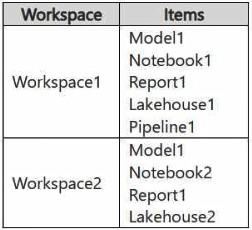Microsoft Implementing Data Engineering Solutions Using Microsoft Fabric DP-700 Exam Practice Test
You have two Fabric workspaces named Workspace1 and Workspace2.
You have a Fabric deployment pipeline named deployPipeline1 that deploys items from Workspace1 to Workspace2. DeployPipeline1 contains all the items in Workspace1.
You recently modified the items in Workspaces1.
The workspaces currently contain the items shown in the following table.

Items in Workspace1 that have the same name as items in Workspace2 are currently paired.
You need to ensure that the items in Workspace1 overwrite the corresponding items in Workspace2. The solution must minimize effort.
What should you do?
Answer : D
When running a deployment pipeline in Fabric, if the items in Workspace1 are paired with the corresponding items in Workspace2 (based on the same name), the deployment pipeline will automatically overwrite the existing items in Workspace2 with the modified items from Workspace1. There's no need to delete, rename, or back up items manually unless you need to keep versions. By simply running deployPipeline1, the pipeline will handle overwriting the existing items in Workspace2 based on the pairing, ensuring the latest version of the items is deployed with minimal effort.
You have an Azure key vault named KeyVaultl that contains secrets.
You have a Fabric workspace named Workspace!. Workspace! contains a notebook named Notebookl that performs the following tasks:
* Loads stage data to the target tables in a lakehouse
* Triggers the refresh of a semantic model
You plan to add functionality to Notebookl that will use the Fabric API to monitor the semantic model refreshes. You need to retrieve the registered application ID and secret from KeyVaultl to generate the authentication token. Solution: You use the following code segment:
Use notebookutils. credentials.getSecret and specify key vault URL and the name of a linked service.
Does this meet the goal?
Answer : B
You have a Fabric workspace that contains an eventstream named EventStreaml. EventStreaml outputs events to a table named Tablel in a lakehouse. The streaming data is souiced from motorway sensors and represents the speed of cars.
You need to add a transformation to EventStream1 to average the car speeds. The speeds must be grouped by non-overlapping and contiguous time intervals of one minute. Each event must belong to exactly one window.
Which windowing function should you use?
Answer : C
Note: This question is part of a series of questions that present the same scenario. Each question in the series contains a unique solution that might meet the stated goals. Some question sets might have more than one correct solution, while others might not have a correct solution.
After you answer a question in this section, you will NOT be able to return to it. As a result, these questions will not appear in the review screen.
You have a Fabric eventstream that loads data into a table named Bike_Location in a KQL database. The table contains the following columns:
BikepointID
Street
Neighbourhood
No_Bikes
No_Empty_Docks
Timestamp
You need to apply transformation and filter logic to prepare the data for consumption. The solution must return data for a neighbourhood named Sands End when No_Bikes is at least 15. The results must be ordered by No_Bikes in ascending order.
Solution: You use the following code segment:

Does this meet the goal?
Answer : B
This code does not meet the goal because this is an SQL-like query and cannot be executed in KQL, which is required for the database.
Correct code should look like:

You have a Fabric workspace named Workspace1 that contains an Apache Spark job definition named Job1.
You have an Azure SQL database named Source1 that has public internet access disabled.
You need to ensure that Job1 can access the data in Source1.
What should you create?
Answer : B
To allow Job1 in Workspace1 to access an Azure SQL database (Source1) with public internet access disabled, you need to create a managed private endpoint. A managed private endpoint is a secure, private connection that enables services like Fabric (or other Azure services) to access resources such as databases, storage accounts, or other services within a virtual network (VNet) without requiring public internet access. This approach maintains the security and integrity of your data while enabling access to the Azure SQL database.
Note: This question is part of a series of questions that present the same scenario. Each question in the series contains a unique solution that might meet the stated goals. Some question sets might have more than one correct solution, while others might not have a correct solution.
After you answer a question in this section, you will NOT be able to return to it. As a result, these questions will not appear in the review screen.
You have a Fabric eventstream that loads data into a table named Bike_Location in a KQL database. The table contains the following columns:
BikepointID
Street
Neighbourhood
No_Bikes
No_Empty_Docks
Timestamp
You need to apply transformation and filter logic to prepare the data for consumption. The solution must return data for a neighbourhood named Sands End when No_Bikes is at least 15. The results must be ordered by No_Bikes in ascending order.
Solution: You use the following code segment:

Does this meet the goal?
Answer : B
This code does not meet the goal because it uses order by, which is not valid in KQL. The correct term in KQL is sort by.
Correct code should look like:

You need to recommend a solution for handling old files. The solution must meet the technical requirements. What should you include in the recommendation?
Answer : B